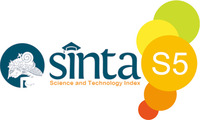Lexical cohesion in the commercial advertisements of five Korean magazines
Abstract
Keywords
Full Text:
PDFReferences
Abedi, M., Bayat, A., & Ahmadi, H. (2023). The role of extensive listening tasks in the use of discourse markers by Iranian intermediate EFL learners in their oral production of stories. Research in English Language Pedagogy, 11(3), 356-373. https://doi.org/10.30486/relp.2022.1966194.1401.
Agustiningsih, G. (2021). Application of copywriting elements in social media advertising drinking products now in creating consumer interest. Jurnal Komunikasi dan Bisnis, 9(1), 55-67. https://doi.org/10.46806/jkb.v9i1.678.
Batubara, M. H., Rahila, C. D. I., & Ridaini, R. (2021). An analysis lexical cohesion in Jakarta post news. Journal of Linguistics, Literature, and Language Teaching (JLLLT), 1(1), 1-7. https://doi.org/10.37249/jlllt.v1i1.278.
Davari, M. (2022). Online reformulation and collaborative feedback: Its effect on EFL learners’ writing performance during the COVID-19 pandemic. International Journal of Research in English Education, 7(2), 101-118. http://doi.org/10.52547/ijree.7.2.101.
Dini, J. P. A. U. (2022). Critical discourse analysis in the classroom: A critical language awareness on early children’s critical thinking. Jurnal Obsesi: Jurnal Pendidikan Anak Usia Dini, 6(5), 4992-5002. https://doi.org/10.31004/obsesi.v6i5.2951.
Endri, E. (2020). Evaluation of overseas field study program at the Indonesia Defense University. International Journal of Innovation, Creativity and Change, 12(10). 554-573.
Favier, S., Meyer, A. S., & Huettig, F. (2021). Literacy can enhance syntactic prediction in spoken language processing. Journal of Experimental Psychology: General, 150(10), 2167-2174. https://psycnet.apa.org/doi/10.1037/xge0001042.
Hong, K. S., & Jung, Y. H. (2021). 청년세대의 텔레비전 드라마 수용 연구 : JTBC 드라마 〈이태원 클라쓰〉의 공감과 재미 요소를 중심으로 (A study on the television drama reception among the youth : focusing on the elements of interest and sympathy in watching JTBC drama 〈Itaewon Class〉). Korean Journal of Journalism, 65(2), 330-369, https://doi.org/10.20879/kjjcs.2021.65.2.009
Jacob, S. D., & Rahman, N. A. A. (2022). Analisis bahasa dalam iklan media sosial di Malaysia (Analysis of language in social media advertisements in Malaysia). Jurnal Komunikasi Borneo (JKoB), 10, 13-28.
Kim, J. (2021). Advertising in the metaverse: Research agenda. Journal of Interactive Advertising, 21(3), 141-144. https://doi.org/10.1080/15252019.2021.2001273.
Kim, Y. H. (2020). 소비자 감성을 반영한 가구브랜드 마케팅 연구-2010 년 이후 국내외 사례를 중심으로 (A study on the marketing of furniture brand reflecting consumer sensitivity - focusing on domestic and international cases since 2010 -). Journal of the Korean Society of Furniture, 31(3), 205-216.
Mahlberg, M. (2006). Lexical cohesion corpus linguistic theory and its application in English language teaching. International Journal of Corpus Linguistics, 11(3), 363-383. https://doi.org/10.1075/ijcl.11.3.08mah.
Mandarani, V. (2020). Grammatical and lexical cohesion analysis of trump’s speech upon soleimani assassination. Jurnal Basis, 7(1), 131-140. https://doi.org/10.33884/basisupb.v7i1.1753.
Masrukhi, M., & Hadi, S. (2014). Struktur iklan komersial di media cetak Mesir (Structure of commercial advertisement in Egypt printed 126 media). Center of Middle Eastern Studies (CMES): Jurnal Studi Timur Tengah, 7(2), 126-139. https://dx.doi.org/10.20961/cmes.7.2.13460.
Murodi, A., Hidayat, D. N., & Alek, A. (2021). An investigation of lexical cohesion on Indonesian singer song. Jurnal Onoma: Pendidikan, Bahasa, Dan Sastra, 7(1), 15-23. https://doi.org/10.30605/onoma.v7i1.448.
Nai, F. A. (2021). Proposisi kondisional dalam iklan layanan masyarakat masa pandemic covid-19 (Conditional propositions in public service advertisements during the Covid-19 pandemic). Jurnal Lazuardi, 4(2), 22-47. https://doi.org/10.53441/jl.Vol4.Iss2.60.
Nurdiyana, M., & Qorib, F. (2023). Persepsi wartawan terhadap kualitas berita di media massa kota Malang (Journalists' perceptions of the quality of news in the Malang city mass media). Lenvari: Journal of Social Science, 1(1), 9-22. https://doi.org/10.61105/jss.v1i1.21.
Sari, A. J. C., Mujiyanto, J., & Rukmini, D. (2022). Assessing the use of cohesive devices in reading texts of English textbook. English Education Journal, 12(2), 264-273. https://doi.org/10.15294/eej.v12i2.56996.
Sidabutar, U. (2021). An analysis of lexical cohesion on the students’ writing. JETAL: Journal of English Teaching & Applied Linguistic, 2(2), 62-67. https://doi.org/10.36655/jetal.v2i2.533.
Suleman, D. (2023). Strategi copywriting untuk menulis promosi offline atau online (Copywriting strategies for writing offline or online promotions). PaKMas: Jurnal Pengabdian Kepada Masyarakat, 3(1), 1-6. https://doi.org/10.54259/pakmas.v3i1.1543.
Telaumbanua, T. (2021). Grammatical and lexical cohesion in Ed Sheerans’song lyrics in the “plus” album. Jurnal Education and development, 9(2), 656-660.
Utomo, S. (2022). Leadership role of school principles to motivate teachers promotion at public junior high school 4 Kudus in 2021. ANP Journal of Social Science and Humanities, 3, 30-39. https://doi.org/10.53797/anp.jssh.v3sp2.4.2022.
Widyawati, A. (2017). Bahasa iklan penawaran barang atau jasa dan implementasinya dalam pembelajaran bahasa indonesia di sekolah dasar (Advertising language offering goods or services and its implementation in Indonesian language learning in elementary schools). Stilistika: Kajian Bahasa, Sastra, dan Pembelajarannya, 3(2), 1-8. https://doi.org/10.32585/.v3i2.77.
DOI: https://doi.org/10.17509/jokal.v1i1.33111
Refbacks
- There are currently no refbacks.
Copyright (c) 2021 Journal of Korean Applied Linguistics

This work is licensed under a Creative Commons Attribution-ShareAlike 4.0 International License.

Journal of Korean Applied Linguistics published by Universitas Pendidikan Indonesia is licensed under a Creative Commons Attribution-ShareAlike 4.0 International License.




